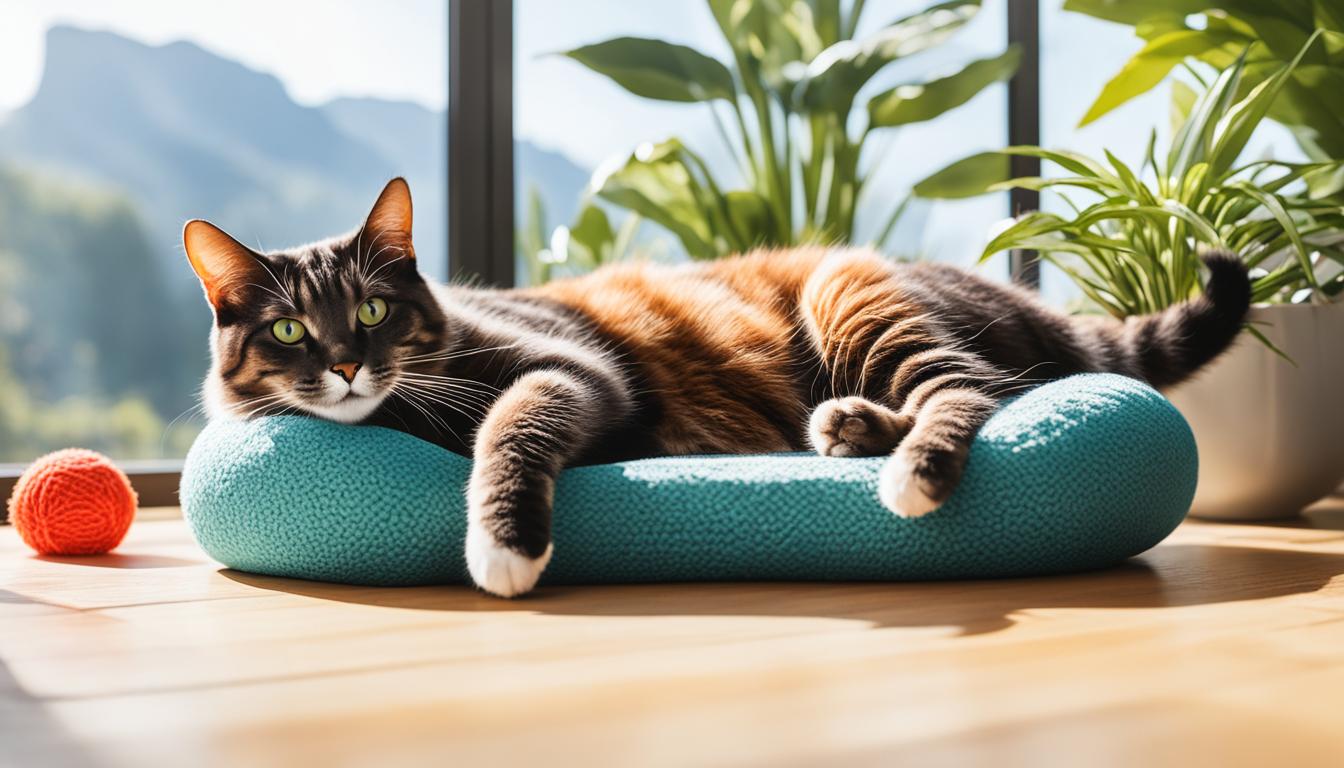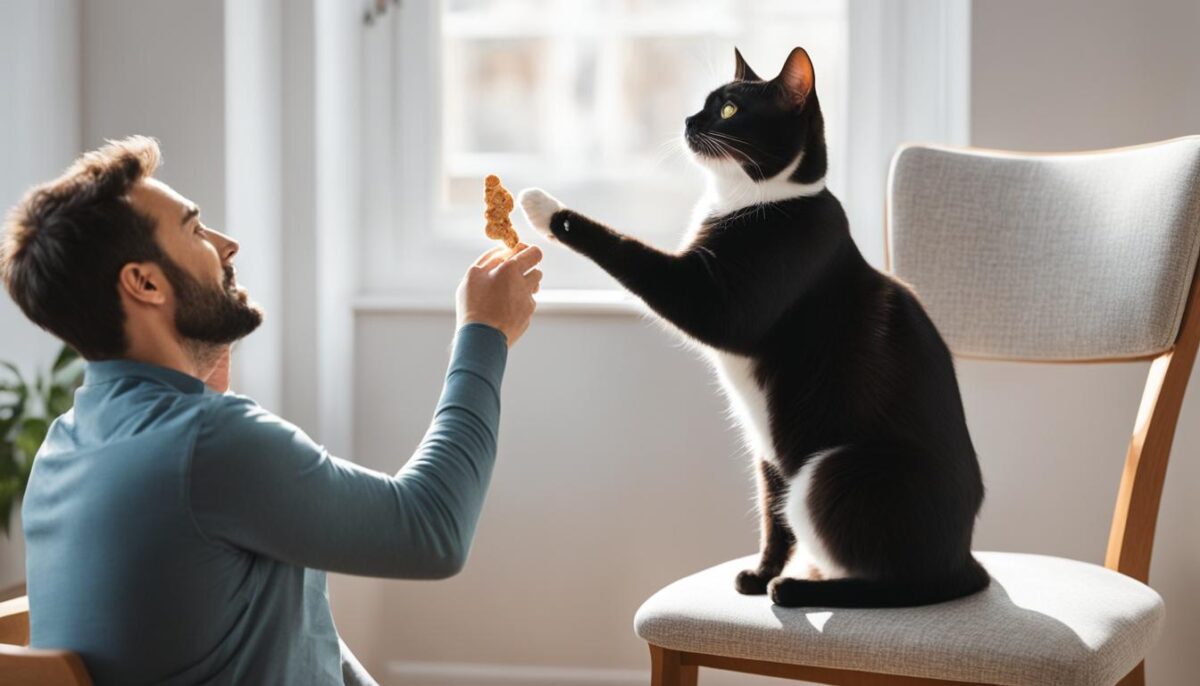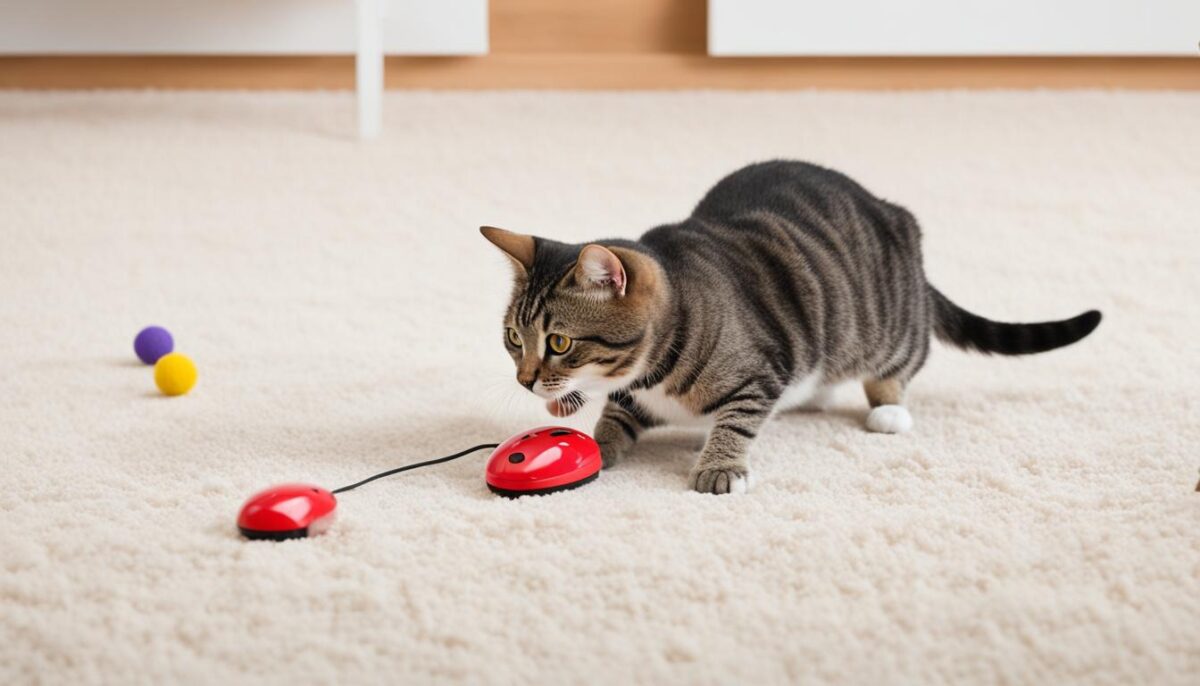Hey there! If you have a new furry friend at home, you might be thinking about how to train your new kitten. Training a cat can make both your life and your cat’s life better. Think of it like teaching your cat how to be a good friend. Cats can learn cool things that help them be happy and healthy cats. We use special cat training techniques that are kind of like games. When your cat does something great, you give them a treat or play with them. This helps them learn what you like them to do!
It’s not hard, but there are some secrets to making it fun for you and your kitty. You’ll need to be kind and patient, but don’t worry – you’ve got this! And the best part? While teaching your cat, you spend fun time together and become best buddies. Ready to start? Let’s go!
Key Takeaways
- Start training your cat with love and patience.
- Use treats and playtime as rewards.
- Keep training sessions short and fun.
- Be patient and keep trying, even if it takes time.
- Training helps you and your cat be the best of friends.
Understanding the Basics of Cat Training
Do you ever wonder why your furry friend needs training? Just like us, cats have a lot to learn to be their happiest selves. Knowing why and how to train your buddy is the first step to a happy life together.
Why Training Your Cat Is Important
There are many reasons for cat training. It’s all about helping your cat feel good inside and out. When you train your cat, you give them fun things to do which makes their brains happy and keeps them from getting bored or doing things we don’t like. Plus, when you spend time training your cat, you create a strong friendship.
How Cats Learn: Association of Behavior and Rewards
Cats are smart! They learn by making links between what they do and what happens after. It’s like if you do all your homework, you might get extra playtime. Cats get it the same way. If they do something good and get a nice treat or some fun playtime right away, they remember that and will do it again. We can teach them this using tools like clickers and simpe hand moves. And when we get to know when they like learning the most, we can teach them even better!
Training is not just about tricks, it’s about communication.
Positive reinforcement in cats is about rewarding the good stuff they do. If they sit nicely or use the litter box right, we give them a yummy treat or a loving scratch. This makes your cat want to do it again because they know something great comes after.
Association learning in felines is all about helping them understand that good behavior means good rewards. You’ll need to reward them right when they do something great, and do it every time so they really understand.
| What Cats Learn | How to Reward | Best Time to Train |
|---|---|---|
| Using the litter box | Give them a treat | After meals |
| Coming when called | Play with a favorite toy | When they’re alert and not sleepy |
| Sitting calmly | Pet and praise them | Before mealtime when they’re hungry for rewards |
So there you go! Understand why training is cool for your cat and how they learn best. It makes your cat smart and your friendship strong! Plus, it’s a lot of fun. So why not give it a try?
Cat Training Advice: Paving the Path to Obedience
Have you ever thought about teaching your cat commands? It’s not just for dogs! With cat obedience training, you can help your kitty learn to listen and do some pretty cool things. Imagine your cat sitting when you ask or coming when called. That’s all part of cat behavioral training.
Training should be fun, like a game you and your cat play. Cats are smart and can learn quickly when they’re having a good time. Be sure to give lots of praise and treats when your cat does what you ask. This is called “positive reinforcement,” and it’s a big help in training your kitty.
To begin, you can try some simple commands like “sit” or “come.” Don’t worry if your cat doesn’t get it right away. Each cat learns at their own pace. You just need to be patient and keep trying. And remember, always be kind to your cat. Yelling or being mean won’t help your cat learn.
- Start with easy commands like “sit” or “stay.”
- Use a treat to guide your cat into the right position.
- Have short, happy training sessions each day.
- Always give your cat a treat or cuddle for a job well done.
As you and your cat work together, you’ll become better friends and have lots of fun. So why not start cat obedience training today? Grab some treats and let the learning begin!
Incorporating Play into Cat Training Sessions
Training your cat can be lots of fun! When you mix playful cat training with learning, it helps your cat listen better and learn faster. It’s important to pick toys that are safe and exciting for your kitty. Let’s find out how to pick the best toys and use them to make training a game.
Choosing the Right Playthings
What toys should you use? Think about toys that move like real prey, such as mice or birds. These toys make your cat’s hunting skills come alive! Here are some tips for picking out great toys:
- Look for toys that your cat can chase, like a toy on a string.
- Use small balls that roll to keep your cat running around.
- Soft stuffed toys can be carried around in your cat’s mouth.
Remember, every cat is different. Some cats might like feather toys while others prefer jingle balls. So, see what makes your cat the happiest!
Integrating Playtime with Training Tips
Now let’s talk about how to make training feel like a game. You can use your cat’s favorite toy to teach them new skills. Plus, having special playtimes after training will make your cat look forward to learning new things. Here’s how you can do this:
- Use toys as a reward when your cat gets something right.
- Set up a rug or a mat where your cat knows it’s playtime.
- Show your cat tricks like ‘come’ or ‘sit’ and then have fun with a game.
Also, you can make a game out of training. Hide treats around the room and let your cat find them. It will be like a treasure hunt that teaches your cat to come when you call!
| Toy | Use in Training | Benefits |
|---|---|---|
| Feather Wand | Encouraging jumps and leaps after command | Builds agility and strength |
| Treat Ball | Rolling to teach ‘follow’ or ‘roll over’ | Teaches cats to solve puzzles |
| Laser Pointer | Pointing to spots for ‘go to’ training | Improves focus and speed |
Training with toys is not just about following rules, it’s about having a great time with your furry friend. With the right toys and games, your cat will learn quickly and have a paw-some time! Remember, being patient and kind is the best way to teach your cat. Now, let’s get those toys ready and start the fun!
Essential Strategies for Litter Training and Carrier Training
Getting your cat to use a litter box and feel comfy in a carrier doesn’t have to be tough. With patience and these easy steps, you can teach your kitty to be a pro at both. First, let’s talk about litter box training. It’s all about making the litter box a place your cat wants to go. Put the box in a spot that’s quiet and easy for your cat to reach, especially right after they eat. Show your cat what to do by gently taking their paw and pretending to dig in the litter.
Now, onto making your cat’s carrier feel like a safe hangout. The key to cat carrier comfort is to let your cat check it out on their time. Leave it open in a place they like, with some yummy treats inside. This way, your kitty can explore it with no pressure. Once they’re used to it, try closing the door for just a bit, then a bit longer, and give them treats when they’re calm. Talk softly and pet them to show them everything’s okay. Soon, your cat will be all set for travel, and you’ll have top-notch cat traveling tips to share!
- Put litter box in a quiet place your cat can always get to.
- After meals, bring your cat to the box and help them ‘dig’.
- Make sure the box is always clean – cats like it tidy!
- Leave the carrier out in a safe spot with the door open.
- Place treats inside to make it really tempting to go in.
- Start closing the door for short times, then longer, while giving treats.
- Move the carrier around the house with your cat inside, comforting them with kind words.
| Litter Box Tips | Carrier Comfort Steps |
|---|---|
| Place it in a calm area | Keep it open in a familiar place |
| Show them how to dig | Lure with treats and soft bedding |
| Keep it clean | Gradually increase the time with the door closed |
| Easy to find after meals | Always use gentle words and petting |
Discouraging Problem Behaviors in Cats
Having a kitty as your friend is a lot of fun, but sometimes they do things we wish they wouldn’t, like scratching your couch or biting when they play. It’s important to help them learn what’s okay and what’s not in a kind way. Let’s talk about how to make those naughty habits go away with love and patience.
Addressing Scratching and Biting
Scratching and biting are natural for cats, but we don’t want them to use their claws and teeth on us or our stuff. To help your cat stop these behaviors, give them their own things to scratch and bite. A tall scratching post or a sturdy toy can make all the difference and keep everyone happy. Remember, never yell or be rough with your cat. This will only scare them and make things worse.
Preventing Misbehavior with Positive Reinforcement
Positive reinforcement is about giving your cat good things when they do what you like. This teaches them to repeat those good behaviors. When your cat uses their scratching post or plays without biting, give them a treat or some cuddle time. This shows them they’re doing great! Using soft words and gentle petting helps too. It makes them feel good and they’ll want to keep doing the right things.
| Problem Behavior | What To Do | What To Give as a Positive Reinforcement |
|---|---|---|
| Scratching furniture | Place a scratching post nearby | Praise or catnip on the scratching post |
| Bitting during play | Use a treat to encourage licking instead | A special toy or extra playtime |
Kitties are smart and full of love. When you’re patient and teach them with kind methods, they learn to trust you and how to be the best kitty friend they can be. And that makes both of you very happy!
Cat Training Advice: Nurturing a Positive Relationship with Your Pet
When you train your cat, it’s like playing a fun game where both of you win. Every time your kitty does something right and you reward them, it feels good for both of you. This helps make a very strong bond between you and your furry friend. It’s like building a tower of trust, where each good moment adds another block.
To grow a positive cat-owner relationship, try to learn what your cat is saying with their tail and whiskers. Cats talk with their bodies. When they’re happy, they might purr and rub against you. If they are scared, they may puff up and hiss. Knowing these signs means you understand your pet better and can make sure they feel safe and loved.
You can show your cat they can count on you by being gentle and patient. It’s important to give them their own space to relax. Just like you have a favorite spot to chill, your kitty does too! When you respect that, your cat knows you care. Training sessions that end with a cuddle or a treat will teach your cat that being with you is the best.
- Use gentle words and actions to make your cat feel safe.
- Play with your cat every day with their favorite toys.
- Give treats as rewards for good behavior – it’s like a high-five for cats!
- Keep training fun – if you’re both enjoying it, you’re doing it right!
Building trust with felines takes time, but it’s worth it. Every trick learned and every game played together adds to the friendship you share. Cat companionship is a special thing and with love and patience, it will grow stronger every day. Remember, training your cat isn’t just about teaching tricks, it’s about spending happy times together and becoming best buddies.
Conclusion
When you spend time training your cat, you do more than teach them cool moves. You’re building a special friendship. Think about it like learning to dance together. You guide, and your cat follows your steps. This back-and-forth creates trust and lots of smiles. By showing your cat what you like with treats and games, they’ll want to do those things more. This way, you help your cat act better, making life with them super fun!
Cat training is a big win for everyone. It stops naughty habits like clawing the couch or nipping fingers. Plus, it opens a world where you both understand each other better. Happy cats listen well and cuddle more. Isn’t that sweet? Remember, a big part of training is saying ‘good job’ to your cat with pats and treats. This keeps them eager and full of purrs.
In the end, taking the time for cat training shapes a wonderful world for you and your furry buddy. It paves the way for many purr-fect days ahead. Your cat becomes happier and everyone notices how good they are. That’s what you get with successful cat training outcomes—a buddy for life who’s cheerful at home and around folks. So keep up the great work with your cute cat!
FAQ
Can I really train my cat like a dog?
While cat training techniques differ from those used with dogs, cats can indeed learn useful behaviors and tricks. Training your cat with consistent, positive reinforcement can lead to a happy and healthy companion.
Why is it necessary to train my cat?
Training your cat is important because it enhances their mental stimulation, helps prevent unwanted behaviors, and strengthens the bond between you and your pet.
What is the best way to start training a new kitten?
Start with simple commands and consistent positive reinforcement. Short, regular training sessions that fit into your kitten’s daily routine are the best approach.
How do I ensue my cat associates their behavior with a reward?
Use immediate and consistent rewards for good behavior. Tools like clickers can help signal to your cat that a reward is coming, reinforcing the positive action.
What are the basics of cat obedience training?
Begin with simple commands like ‘sit’ or ‘come’ and always use positive reinforcement. Understand your cat’s personality and tailor the training to their unique traits and preferences.
How can I make my cat’s training sessions more engaging?
Incorporate play with toys that appeal to their natural hunting instincts, and use these toys as rewards during training sessions. This keeps them motivated and interested.
What’s essential for effective litter box training?
Consistency and a clean, quiet location for the litter box are key. Introduce your cat to the box after meals and use positive reinforcement when they use it correctly.
How do I get my cat comfortable with their carrier?
Gradually acclimate your cat to the carrier by placing treats inside and creating a comfortable environment. Increase the time they spend in the carrier with the door closed to build up their comfort level.
What should I do about my cat’s scratching and biting?
Provide appropriate outlets for these behaviors, such as scratching posts, and use deterrents for furniture. For biting, redirect with treats or toys and always reward gentle play.
How do I reinforce good behavior without punishing my cat?
Use positive reinforcement methods, such as treats and praise, to encourage desired behaviors. Consistency with these rewards is more effective than using punishment.
Why is it crucial to build a trusting relationship during training?
Training is not just about teaching tasks; it’s about developing a deeper bond with your cat. Understanding and respecting each other fosters trust and makes training more effective.
How can I tell if my cat’s behavior is improving from training?
Look for reduced problem behaviors, a responsive attitude to commands, and an overall increase in good behavior. These signs indicate successful training and a more enriching life for both of you.


